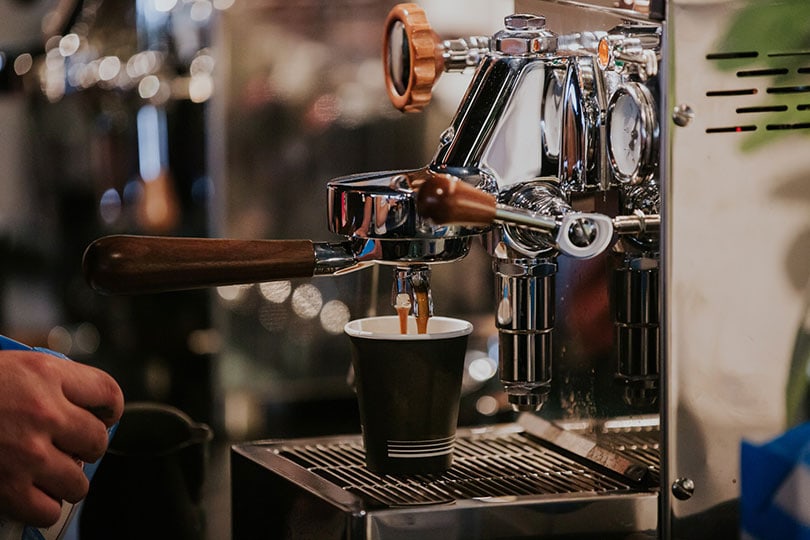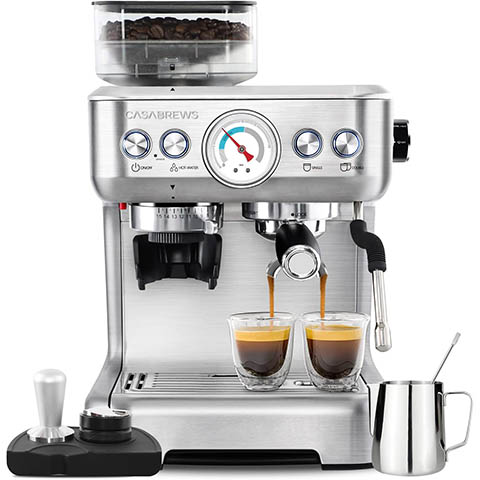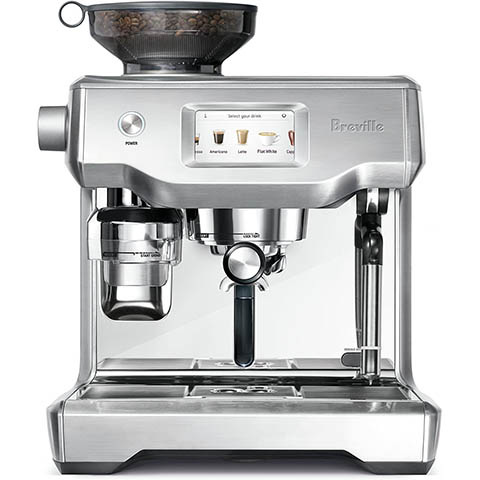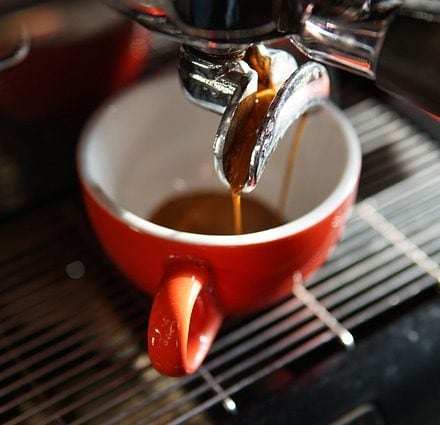
If you’re considering starting a coffee shop, you will likely need a commercial espresso machine to make many popular beverages, but you might wonder how much they cost. The short answer is that commercial units can be quite expensive, starting at about $500. Keep reading as we look at the different features that these machines offer and the cost of a few of the most popular brands to help you make an informed purchase.

The Importance of Commercial Espresso Machine
An espresso machine makes great-tasting coffee that many customers prefer over traditional home brew options. Instead of the drip method, espresso machines force hot, pressurized water through the coffee beans to instantly extract flavor, oils, and caffeine. Some devices will have a bean grinder, and many will also have a tea dispenser and a steam wand for frothed milk.
How Much Does a Commercial Espresso Machine Cost?
Pressurization
Steam Power
Steam-powered espresso machines usually cost less than pump-powered machines, but unfortunately, these low-cost machines typically don’t have enough pressure, and the coffee is often weak and watered down, so it isn’t a great option for a commercial business.
Pump Power
The original espresso machines used steam power, but they were inconsistent. It wasn’t until the invention of pump-powered espresso machines that the brewing method became popular outside of its Italian origin. These machines are more expensive but can provide consistent coffee cup after cup.

Shots and Automation
Semi-Automatic Brewing
When using a semi-automatic brewing system, you have more control over the brewing process than the other types. For example, you can start and stop each shot using a lever or button. You can also set the grind of the beans and steam the milk.
Automatic Brewing
An automatic brewing system still enables you to control the grind of the beans, and you can start each shot, but the machine will determine how long to pull the beverage and will stop when it’s finished. You can also usually steam the milk with these machines.
Superautomatic Brewing
A machine that features superautomatic brewing is completely automated. It will usually grind the beans, pull the shots, and steam the milk without input from the operator after it’s set up. It’s a great choice for consistent coffee but allows for the least control over each cup.

Electronic Display
Machines with an electronic display are more expensive than traditional gauges. They can provide much more detailed information, including how long you pull a shot, water temperature, pressure, etc., so your drinks stay consistent. It can also make it easier to program the machine for automatic brewing, but it isn’t essential for good coffee, and a talented barista can make great coffee without the electronics at a lower cost.
Tea Water Dispenser
Many commercial espresso machines come with a second water spout for tea. However, it will be missing on certain less expensive units. If you don’t anticipate making much tea, you can purchase a commercial espresso machine without a tea water dispenser to save costs.
Steam Wand
A steam wand is an important tool on any espresso machine, as it helps you steam the milk so it’s creamy and smooth. But it’s a component that low-cost models tend to skimp on. Low-quality wands often have a black plastic end with a single hole and offer little control over the steaming process. High-end units will have two to four holes at the end of the wand, and they swivel around so you can get the best angle for steaming, offering more control over the process.

Plumbing or Water Reservoir
You will likely want a commercial espresso machine that connects directly to your plumbing. This way, you can be connected directly to a water line so you don’t need to keep refilling your machine. However, if that is not possible, many devices have a water reservoir that you can fill to make your espresso shots. A device that connects directly to your water line will be more expensive than one with a water reservoir.

Examples of Commercial Espresso Machines to Compare Costs
CASABREWS Espresso Machine — $649

The Casabrews Espresso Machine has a built-in 92-ounce removable reservoir, professional steaming wand, and built-in bean grinder. It uses pump power and makes espresso using a semi-automatic system and enables you to make single or double shots.
Breville Oracle Touch Espresso Machine — $2,799

Breville Oracle Touch Espresso Machine has an attractive digital display that enables you to select your drink via touchscreen. Depending on your selection, it uses an automatic process to grind the beans and brew one or two shots of espresso.
Nuova Simonelli Appia II Volumetric 2 Group Espresso Machine — $9,395

The Nuova Simonelli Appia II Volumetric 2 Group Espresso Machine is ideal for opening a coffee shop. This machine connects to your water line and comes with free installation. It has a large capacity and uses an automatic system that is easy to understand. It has an automatic boiler refill, a hot water spigot, and two movable steam arms that remain cool to the touch.

Additional Costs to Anticipate
Plumber
Additional costs that you can anticipate might include connecting your commercial espresso machine to your plumbing, which could require hiring a licensed professional to run additional pipes, solder joints, etc. Besides the labor, you also need to pay for any materials and supplies.
Additional Items
You might need additional items later if you purchased a budget commercial espresso machine with no extra features. For instance, if your device does not have a tea water dispenser, you may need to buy a teapot. You may also need a timer to time your pools if your machine does not have an electronic display.
How Often Should I Replace My Commercial Espresso Machine?
Commercial espresso machines typically last 6 to 10 years. Naturally, a high-end appliance will usually last longer than a budget model, and one that gets used more frequently will likely die faster than one that sits in the corner.

What Should I Do to Keep My Espresso Machine in Good Shape?
Clean It Frequently
Dust and powder from the ground beans can clog the lines, and bacteria can grow in an unkept machine. Frequent cleaning will help keep the device running smoothly and help the espresso taste better.
Turn It Off
Since the machine sits idly when not in use, many people leave it on. However, doing so can damage the electrical components over time. Shutting it off when not in use can help it last longer and reduce your energy costs. It will also help you be more environmentally friendly.
Make Sure There’s Always Enough Coffee in the Tank
The manufacturer designed your machine to run with a specific amount of coffee in the tank. Allowing it to run low can damage the pump, reducing productivity and shortening the life expectancy of the machine. Always follow the instructions in the manual to make sure there’s enough coffee in the tank.
Choose the Right Grind
Using the wrong grind of coffee can have a similar effect as allowing the coffee in the tank to get low. Manufacturers design the components to work together, and using the wrong grind can strain the pump, reducing the life expectancy of the machine. If your machine has a built-in grinder, there is no need to worry, but if you grind the beans in a separate device, make sure you use an espresso grind setting.

Conclusion
Unfortunately, commercial espresso machines can get quite expensive. You can expect budget models to start at around $500 and move up to $10,000 or more, depending on the quality of the device and the features that you desire. If your business is just getting started, though, a lower-cost machine will enable you to get going, and you will quickly find it invaluable for quickly making tea and steaming milk for many beverages that don’t even contain espresso.
Featured Image Credit: Isabela Kronemberger, Unsplash
Table of Contents
- The Importance of Commercial Espresso Machine
- How Much Does a Commercial Espresso Machine Cost?
- Examples of Commercial Espresso Machines to Compare Costs
- Additional Costs to Anticipate
- How Often Should I Replace My Commercial Espresso Machine?
- What Should I Do to Keep My Espresso Machine in Good Shape?
- Conclusion













